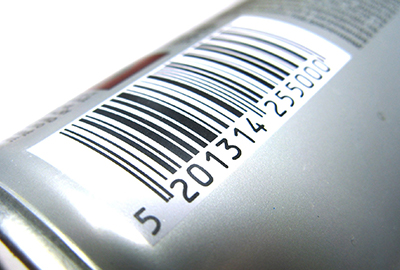Prevent human error in product manufacturing, transportation, storage, and accounting. Knowing how barcodes assist you in better controlling your product logistics, merchandising, inventory, and sales can help you run a more efficient and profitable operation.
atlantagraphicsandprinting.com gathered the following information and tips on how barcodes work, the information they can store, and the different barcode types you can use to control your inventory.
What is a Barcode?
A barcode is a printed method of representing data in a visual, machine-readable form. Originally, barcodes represented alpha-numerical data by varying parallel line widths, spacings, and sizes.
How a Barcode Works
A one-dimensional barcode is read using a barcode scanner. The fixed or hand-held scanner emits a laser that detects the pattern. When the laser sweeps across a barcode, some light is absorbed while the rest reflects.

More specifically, the sensor in a barcode scanner detects reflected light from the illumination system (the red laser light) and generates an analog signal that is conveyed to the decoder. The decoder interprets the signal, validates the barcode using the check digit, and converts it into readable text and numerical values.
Can I Make My Own Barcode?
Yes and no. A common mistake companies make is creating their own universal product code (UPC) numbers. A company can not randomly create its own UPC number. To have a valid UPC code that scans at the Point of Sale, the UPC number must contain a GS1-assigned Company Prefix, also known as a manufacturer prefix.
Note: The GS1 Company Prefix is the UPC Company Prefix with a leading zero and is an important unique identifier enabling companies to identify logistic (shipping) barcodes, coupons, and allow traceability.
Some corporations will use private labeling for their merchandise, utilizing a Stock Keeping Unit (SKU) represented as a printed barcode on the product’s label. It’s also a great option if you need barcodes for internal uses like stock keeping or asset tracking.
Barcode Types
One of the most commonly used barcode types is UPC (Universal Product Code). This barcode is used for labeling retail products. UPC codes can be found on almost every sale item in the market and all grocery stores in the US.
A UPC consists of a 12-digit numeric-only number. Every product is assigned its unique number by GS1 (making up the first six digits of the barcode). The product’s manufacturer assigns the next five digits. Each product possesses a unique UPC that its manufacturers use for its identification.
There are numerous barcode types, and each presents unique opportunities and limitations. With this range of options to choose from, it can be challenging to determine which barcodes best suit your organization, products, inventory, or assets. Consider the following commonly used barcode types:
UPC Barcodes – Used to label and scan consumer goods at points of sale worldwide. Mainly in the United States, but also utilized in the United Kingdom, Australia, New Zealand, and other countries.
EAN Barcodes – Also used to label consumer goods worldwide for point-of-sale scanning, primarily in Europe.
QR Codes – most often used in tracking and marketing initiatives, like advertisements, magazines, app and website downloads, and business cards. They are flexible in size, offer high fault tolerance, and have fast readability. QR codes support numeric, alphanumeric, byte or binary, and Kanji data.

Codabar Barcodes – These are used by logistics and healthcare professionals (US blood banks, FedEx, photo labs, and libraries). Their principal benefit is that they’re easy to print and can be produced by any impact-style printer.
Code 128 Barcodes – These are compact, high-density codes used in logistics and transportation industries for ordering, tracking, and distribution.
Code 93 Barcodes – Used in logistics to identify packages in retail inventory, label electronic components, and provide delivery information for the Canadian Post.
ITF (Interleaved 2 of 5) Barcodes – This configuration is used to label packaging materials globally. Since they have high printing tolerances, they are ideal for printing on corrugated cardboard. ITF barcodes encode 14 numeric digits and use the complete ASCII set (hex, octal, HTML, and decimal conversions).
PDF417 Codes – These are used for applications that require storing significant amounts of data, like photographs, fingerprints, and signatures.
Datamatrix Codes – These codes are typically used to label small items, goods, and documents. Their tiny footprint makes them ideal for smaller products in logistics, tracking, and operations.
Tip: You can start creating free bar and QR codes by visiting barcode-generator.org
Why We Need Barcodes
Efficiency. With the immense amount of products, logistics, and storage on a global scale, it would be virtually impossible to uniformly ship, track, market, sell, and purchase products and materials.
Barcodes contain better and immediately accessible data. Since a single barcode can be used for inventory and pricing information, you can quickly obtain data for both. They provide fast, reliable data for a variety of applications.
Note: Depending on your needs, barcodes can be customized to contain other relevant product information.
RFID Product Identification

Radio Frequency Identification (RFID) coding technology applies RFID tags to individual items, boxes, or pallets. Tags vary in size, shape, and capabilities. With its small antenna, the tag emits a radio frequency signal picked up and read by a wireless RFID reader, conveying information from the tag about the item it is affixed to. This technology is especially useful in situations where vast quantities of goods must be moved or tracked, or where tracking of item-specific information is necessary.
Barcode Uses
In this article, you discovered essential information about barcodes and tips on how different types are utilized in product manufacturing, storing, shipping, merchandising, tracking, and selling.
Utilizing a barcode system will help your organization efficiently control and track logistics, inventory, and sales, allowing you to identify strengths and weaknesses in your product supply chain by reducing or eliminating human error.
Ignoring the need for product identification with barcodes, QR codes, or RFID technology will leave your organization vulnerable to costly transportation, accounting, storage, and merchandising mistakes.
Sources:
csuci.edu/cpr/documents/2011-2dbarcodeinfo.pdf
uc.edu/content/dam/uc/ce/docs/OLLI/Page%20Content/PRODUCT%20IDENTIFICATION%20CODES%20BAR%20QR.pdf
cedar.buffalo.edu/adserv/postcode.html
bioinfo.wisc.edu/knowledge_base/barcode_types.php

